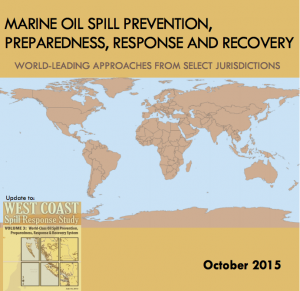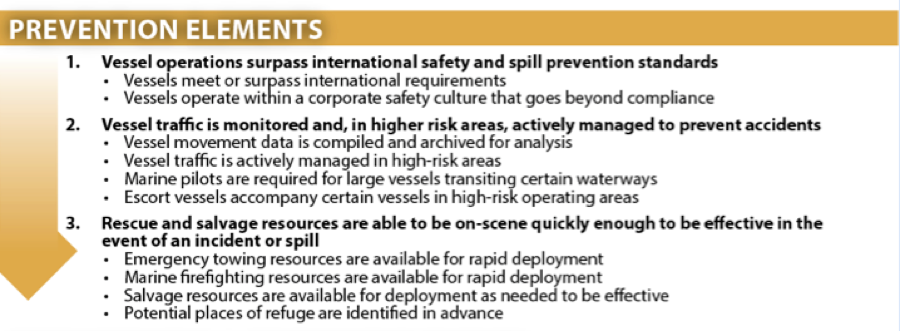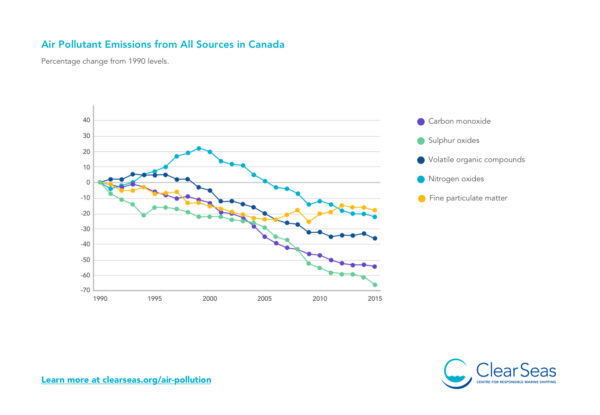This digest covers some of the province’s major observations, specifically those that discuss world-leading prevention systems that build on IMO standards.
Executive Summary
Clear Seas is an independent, not-for-profit organization that provides impartial and evidence-based research to inform the public and policy makers about marine shipping in Canada.We are providing this digest of the BC Ministry of Environment’s report entitled Marine Oil Spill Prevention, Preparedness, Response and Recovery: World-Leading Approaches From Select Jurisdictions.
This short digest is not meant to be inclusive of all the Review’s commentary and/or recommendations, nor are the items mentioned necessarily in the same order as the original report.
Message from the Executive Director
As shipping volumes increase on Canada’s west coast, and with further major marine transportation projects anticipated for BC ports, the government of British Columbia has a vested interest in better understanding the risks particularly associated with increased ship-based oil movements. To that end the British Columbia Ministry of Environment commissioned Nuka Research to conduct a three-volume study to provide an assessment of the current oil spill prevention and response regime on the west coast. The study was completed in 2013.
For marine oil spill prevention, preparedness, response, and recovery – and the provincial government’s aspiration for a world-leading system – it is important to note that it relies on initiatives that are largely beyond provincial jurisdiction – and on a network of international, federal, provincial, and local regulatory and response authorities. As such the recommendations for BC mentioned in the report must be considered in the context of these other jurisdictional realities.
This Volume (published in October, 2015) entitled Marine Oil Spill Prevention, Preparedness, Response and Recovery: World-Leading Approaches From Select Jurisdictions is an update to the original Volume 3 (published in 2013) West Coast Spill Response Study, Volume 3: World Class Oil Spill Prevention, Preparedness, Response & Recovery System.
This digest covers some of its major observations, specifically those that discuss world-leading prevention systems that build on IMO standards. By way of illustration the report points to examples from Australia, Europe, the US and Canada. These examples demonstrate approaches that employ a range of governance structures to create additional layers of safety and spill prevention.
From a Clear Seas perspective, preventing oil spills from happening at all is always the best course of action. However, if they do occur, it is critical that the most efficient mitigation systems are in place. To that end the examples presented are worthy of serious consideration by provincial and federal decision makers.

World-Leading Marine Oil Spill Prevention Examples
This updated volume links the elements in the three-volume 2013 report to the British Columbia government’s aspiration for world-leading standards by presenting specific examples from select jurisdictions around the world that the governments of BC and Canada may look to as model approaches.
In Volume 3 of the 2013 study three common elements of world-class marine oil spill prevention were identified, as per the following table.

It identified a number of “opportunities” for British Columbia and the Government of Canada to make changes, some of which are already underway, to improve Canada’s oil spill response and prevention regime.
Incorporating similar prevention elements, this updated volume discusses seven marine oil spill prevention examples of world-leading systems. The report suggests how BC could model these examples for its own area of concern.
(1) The US Aleutian Islands Risk Assessment is an example of a multi-stakeholder risk assessment focused on vessel traffic in a particular area, specifically on the Alaska Peninsula and Aleutian Island Archipelago. It concentrated on vessels 300 GT [1] or larger and those with at least 10,000 gallons (32 metric tonnes) of fuel capacity. Its stakeholder-driven approach sought to combine local knowledge and outside technical expertise to consider vessel traffic risks and analyze risk reduction options. The outcome was an Optimal Response System that included a suite of prevention measures designed to mitigate local risks.
British Columbia could model its prevention approach by considering the examples of the Aleutian Island assessment by considering:
- Conducting a multi-jurisdictional marine oil spill risk assessment that combines technical analysis with stakeholder, government, and industry input.
- Evaluating marine oil spill threats based on historic and projected vessel movements along the entire BC coast, including risk of spills from cargo and fuel tanks.
- Evaluating potential consequences of marine oil spills with stakeholder and public input.
- Linking marine oil spill-prevention initiatives to identified risks; prioritizing would be based on both threats and consequences.
- Specifying the implementation process – mechanism, timeline, responsibility, costs, etc. – when evaluating risk reduction options.
(2) The establishment of Internationally Recognized Areas to be Avoided (ATBA) provides a mechanism to influence the routing of international vessel traffic. The designation and implementation of an ATBA begins at the international level through the International Maritime Organization (IMO) when international vessel traffic is of concern. ATBA are designed around specific areas based either on their hazards, challenges to rescue, or sensitivity, and may or may not be associated with a Particularly Sensitive Sea Area [2] or other marine protected area designation.
Examples from Alaska and Hawaii focus on vulnerable remote island regions and illustrate how two different, but related approaches, achieve world-leading oil spill prevention in the Pacific Ocean. In both states, the ATBA extend 50nm [3] offshore of the islands. Elements discussed include: enhanced protection of areas vulnerable to risks from international vessel traffic through routing measures that exclude vessels from certain sea areas; applicability to all vessels of a certain class, regardless of flag state or voyage route; inclusion of ATBA on international charts for clear messaging to all mariners; and the compelling of flag states and coastal states to monitor compliance.
Despite strong direction from the IMO, the two ATBA examples cited are still technically only “recommendatory” for vessels that are not flagged to the US (or other coastal state in which they are located), or are not traveling to or from a US port. However, ATBA establish an internationally recognized standard of care and provide a mechanism for the coastal state to take any issues or concerns about a vessel’s route to the flag state
Considerations for modeling BC’s approach to protecting sensitive areas using routing measures, based on the US Areas to be Avoided include:
- Identifying highly sensitive or high priority areas where the risks associated with vessel traffic are too high to tolerate.
- Specifying the special area designation and resultant routing measures in accordance with IMO guidance, and bringing recommendations to the IMO.
- Implementing Areas to Be Avoided, Particularly Sensitive Sea Areas, or other routing measures through international charting and enforcing through port state controls and coordination with flag states.
(3) The European Maritime Safety Agency’s (EMSA) [4] Vessel Safety Initiatives illustrate an approach to oil spill prevention through targeted initiatives aimed at ship-source pollution prevention. EMSA promotes a harmonized approach to vessel safety within the EU, and monitors compliance with EU and international vessel safety standards. It compiles data on ship accidents and makes this data available to other government authorities and the public through searchable databases and summary reports. Many of EMSA’s initiatives indirectly or directly strengthen vessel safety and oversight on a global scale.
Based on the EMSA example, British Columbia and Canada could:
- Collect and analyze vessel casualty data and publish summary statistics and analysis to inform risk management and risk reduction measures.
- Evaluate sufficiency of salvage and rescue resources to respond to incidents along the BC coast.
- Create transparency for port state control/inspection activities by making summary reports and appropriate data publicly available.
- Establish data-driven effectiveness measures to understand how vessel safety initiatives are influencing accident and casualty rates, and identify appropriate course corrections to maximize effectiveness.
(4) Requirements for the use of dedicated escort tugs are a common element of shipping safety regimes. The Ship Escort Response Vessel System (SERVS) in Prince William Sound has been operating for over 20 years in Alaska. It serves four main purposes:
- Monitor conditions along the tanker route;
- Alert the tanker of potential risks or dangers;
- Assist a disabled tanker as quickly as possible; and
- Initiate oil spill containment and recovery operations right away in the event that an incident occurs.
While the system is first and foremost a prevention tool, it also enhances initial oil spill response capability, which could mitigate adverse impacts in the event of a spill.
Two escort tugs accompany each laden oil tanker along the entire 90-mile transit from the Valdez Marine Terminal until they reach the mouth of Prince William Sound, and a sentinel tug remains on station until the tanker is at least 17 nautical miles offshore. Sentinel escorts also accompany ballasted (un-laden) oil tankers along their transits to the Valdez Marine Terminal. A fleet of 11 escort and response tugs is dedicated to the system. Emergency towing procedures and minimum equipment standards are in place for both escort vessels and tankers to increase the likelihood that a towing vessel can assist or save a tanker.
Lessons learned for a similar BC and Canadian model could include:
- Evaluating the capacity of escort vessels (tugs) in areas where tanker escorts are required and considering whether enhancements to the number, type, or capacity of tugs would enhance safety.
- Evaluating whether tug escorts would enhance tanker safety in regions where escorts are not presently required.
- Evaluating regulatory and oversight mechanisms that compel tanker escorts and consider whether mandates are required (vs. voluntary compliance) to achieve risk reduction benefits.
- Compiling and analyzing data on escort tug activities (e.g. rescues or saves, and other assistance rendered).
Port state control is the process by which coastal states exercise their authority to ensure that foreign-flagged vessels visiting their ports comply with international requirements related to ship construction and maintenance, equipment, manning, and operations. This verification typically takes place through inspections. Such systems are in place in most commercial ports worldwide.
(5) Australia’s Port State Control System stands out as an example of how a world-leading approach can be applied to improve the safety standards on vessels calling at ports in a country with one of the world’s largest geographic expanses of marine territory. It relies on strong national laws and a strict enforcement approach and is employed through agency directives (Marine Orders) that can be quickly implemented. It uses a risk-based approach to target ship inspections. It is managed by the Australian Maritime Safety Authority.
Considerations for BC and Canada, based on the Australian example, include:
- Targeting inspections by focusing on vessels with poor safety records (i.e. a history of detentions, past pollution incidents, multiple violations) and prioritizing areas on board ships with high levels of past violations (similar to Australia’s Focused Inspection Campaigns).
- Collecting and analyzing program metrics to assess performance (i.e. measuring how vessel safety is improving based on Port State Control activities).
- Analyzing and publishing annual Port State Control data and statistics.
(6) Aerial surveillance is integral to both oil spill prevention and response. Canada’s National Aerial Surveillance Program (NASP) provides an example of a world-leading oil spill prevention system by utilizing aerial over-flight patrols to detect and deter pollution from ships traveling in Canadian waters. NASP provides aerial lookout to identify ship-source spills, while also monitoring marine traffic and sea ice. The constant possibility for an overhead scan is intended to deter polluters and quickly identify and respond to a spill, while also providing evidence for post-incident legal action.
NASP is funded and maintained by Transport Canada. Information from NASP is passed to departmental and Environment Canada regional offices and is used to enforce legislation related to ship-source pollution.
As the NASP program is already in place in British Columbia, considerations for maintaining and expanding this capacity as part of BC’s oil spill prevention and response regime include:
- Continuing to expand the number of flight hours in the west coast region.
- Continuing to acquire and incorporate new and emerging technologies.
- Incorporating and analyzing data from pollution incidents to identify trends and consider opportunities to link with other vessel safety and pollution prevention initiatives.
Salvage and marine firefighting are two separate but related components of shipboard emergency preparedness. Having adequate resources available to quickly and efficiently control shipboard fires and undertake marine salvage activities may help prevent a shipboard casualty (like a fire, grounding, or collision) from becoming a pollution event.
(7) The US marine fire fighting and salvage regulations require that vessel and non-tank vessel operators develop oil spill contingency plans. The system requires that vessel operators have contracts in place to ensure that marine firefighting and salvage resources can be on-scene and operating within certain time limits. The government also requires operators of US-flagged vessels over a certain size to plan for emergency towing, salvage, and marine firefighting as part of their vessel response planning. Foreign-flagged vessels calling on US ports are also subject to these requirements, which specify timeframes and minimum capability for emergency towing, salvage, and marine firefighting that is tied to the vessel’s size, oil carrying capacity, and area of operation.
For its part British Columbia and Canada could consider:
- Evaluating existing marine firefighting and salvage capacity along the west coast
- Developing additional capacity and distribute it geographically commensurate with risks from vessel traffic.
- Mechanisms to compel the shipping industry to fund marine firefighting and salvage resources.
[1] Gross Tonnage (GTs) is a volumetric measurement of the enclosed space or internal volume in a ship. It is not directly related to the mass or weight of the ship. Gross Tonnage was defined by The International Convention on Tonnage Measurement of Ships, 1969, adopted by the International Maritime Organization, and is used to determine things such as a ship’s manning regulations, safety rules, registration fees, and port dues.
[2] A Particularly Sensitive Sea Area (PSSA) is an area that needs special protection through action by the IMO because of its significance for recognized ecological or socio-economic or scientific reasons and which may be vulnerable to damage by international maritime activities.
[3] A nautical mile is a unit of measurement defined as 1852 meters (approximately 6,080 feet or 1.2 statute miles).
[4] The European Maritime Safety Agency (EMSA) is a European Union agency charged with reducing the risk of maritime accidents, marine pollution from ships and the loss of human lives at sea by helping to enforce the pertinent EU legislation. It is headquartered in Lisbon.



